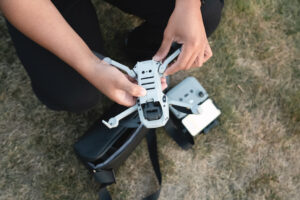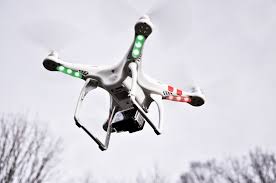Key Takeaways
Understand the importance of frequency and protocol compatibility when selecting FPV transmitters and receivers.
Learn about the standout features of top transmitters like the FrSky Taranis Q X7, Spektrum DX8, and Radiomaster TX16S.
Discover reliable receivers such as the FrSky XM+, TBS Crossfire Nano RX, and ImmersionRC Ghost Atto.
Get insights on matching transmitters with receivers for a seamless FPV experience.
Enhance your flying with ergonomic design, advanced features, and proper setup of your FPV gear.
FPV Essentials: Decoding Transmitter & Receiver Dynamics
When you’re up in the sky, guiding your drone through a breathtaking aerial dance, every move counts. The heart of this control lies in your hands, with the transmitter, and the drone’s response, through the receiver. These two components must speak the same language – a language of frequencies and protocols that ensure your commands are heard and obeyed without a whisper of lag or loss.
Fundamentals: What Makes a Solid FPV Transmitter
The best FPV transmitter is more than just a piece of equipment; it’s your connection to the drone, your instrument of command. It must be reliable, yes, but also comfortable in your hands, responsive to your touch, and equipped with the features you need to soar. Let’s break down the essentials:
Frequency: This is the signal’s playground. Most transmitters operate on 2.4GHz, offering a balance between range and interference resistance.
Protocol Compatibility: Protocols are the rules of engagement for transmitters and receivers. They must match, or they simply won’t work together.
Channel Count: Channels are the paths your commands travel on. More channels mean more controls and customization.
Ergonomics: Comfort is key. If your transmitter feels like an extension of your hands, you’re on the right track.
Ground Control: Picking the Perfect Receiver for Your Drone
On the other end, the receiver is the drone’s ear, keenly tuned to your transmitter’s whispers. It must be light enough not to weigh down your aerial partner but robust enough to catch every nuance of your command. Consider size, weight, and the number of channels it can handle, as these will directly impact your drone’s performance.
Fly Right: Top Transmitters for FPV Thrills
FrSky Taranis Q X7: A Pilot’s Dream Stick
The FrSky Taranis Q X7 is a legend in the FPV community. Its hall-effect gimbals offer precision control, and its open-source software opens a world of customization. Here’s why it’s a pilot’s dream:
Supports up to 16 channels for complex maneuvers.
OpenTX software allows for extensive programming.
Ergonomic design for comfortable, extended flying sessions.
Spektrum DX8: Precision and Power at Your Fingertips
The Spektrum DX8 is your trusty co-pilot, offering not just control but also confidence. Its 8-channel capability is perfect for pilots who demand precision and power. Its user-friendly interface and robust build quality make it a solid choice for both newbies and veterans alike.
Radiomaster TX16S: Versatility Meets Performance
If versatility is your game, the Radiomaster TX16S is your play. With support for multiple protocols, a large color screen, and hall sensor gimbals, this transmitter is a powerhouse that caters to a wide range of drones and pilots’ needs.
FrSky XM+: Tiny but Mighty
Don’t let the small size fool you; the FrSky XM+ receiver is a giant in performance. This little marvel can handle up to 16 channels, providing you with the flexibility to control a wide range of drone functions. It’s incredibly light, making it a non-issue for your drone’s weight balance, and it offers full-range capability, so you’re free to explore the skies without fear of losing connection.
TBS Crossfire Nano RX: For the Long Haul
When it comes to long-range flights, the TBS Crossfire Nano RX stands out. It’s designed for pilots who push the boundaries of distance, ensuring a solid link even when your drone becomes a speck on the horizon. With its robust build and fail-safe functionality, it’s the go-to receiver for serious FPV enthusiasts who demand reliability over vast distances.
ImmersionRC Ghost Atto: Speedy and Sensitive
The ImmersionRC Ghost Atto receiver is all about speed and sensitivity. This cutting-edge receiver boasts low latency for those split-second maneuvers, and its precision is unmatched. Whether you’re racing through gates or smoothly cruising, the Ghost Atto ensures your commands are executed with razor-sharp accuracy.
But remember, it’s not just about picking the best standalone components; it’s about creating a symphony of technology where every piece complements the others. That brings us to the next critical step in our journey.

Gearing Up: Matching Transmitters with Receivers
Think of your transmitter and receiver as a dynamic duo, where compatibility is key to their performance. They need to speak the same language and understand each other’s signals perfectly. This is where the magic of a flawless flight experience comes from.
Most importantly, the protocols of your transmitter and receiver must match. Just like you can’t have a conversation if one person speaks French and the other speaks Mandarin, your drone components need to communicate on the same frequency and with the same protocol to work together.
Protocol Consistency: Ensuring Fluent Communication
Protocols are the rules that govern how your transmitter and receiver talk to each other. If they’re not on the same page, you’ll face disconnections or erratic behavior. So, when choosing your gear, double-check that they’re compatible. If you’re using a FrSky transmitter, for instance, you’ll want a receiver that speaks its language, like the FrSky XM+.
Range Matters: Finding Your Flight Zone
The range is the invisible tether between you and your drone. It defines how far you can fly without losing control. This is crucial, especially if you’re into long-range FPV flying. Transmitters and receivers with a robust range give you the freedom to explore without worry. The TBS Crossfire system is renowned for its impressive range, making it a favorite among long-range pilots.
Battery Life: Maximizing Your Airtime
Battery life is the pulse of your FPV setup. It’s what keeps you in the air, capturing those incredible views. A transmitter with a long battery life means more time flying and less time charging. Look for transmitters with efficient power consumption and the option to swap batteries easily, so you can stay aloft as long as your adventure requires.
Mastering the Sky: Enhance Your FPV Experience
Now, with the right gear in hand, it’s time to fine-tune your setup for that perfect flight experience. This is where you get to personalize your gear, tweak settings, and make sure everything is working in harmony. For a deeper dive into optimizing your equipment, check out our drone upgrade guide to enhance your FPV racing experience.
Software plays a huge role in the performance of your FPV system. It’s the brain behind the brawn, allowing you to adjust settings, update firmware, and calibrate controls. Take the time to learn the ins and outs of your transmitter’s software; it can make all the difference in your flying. For an in-depth guide, consider exploring drone racing tuning with Betaflight, which can significantly enhance your FPV experience.
Software Setup: Configuring for Success
Setting up your software is like setting the stage for a great performance. You’ll want to ensure your transmitter’s firmware is up to date, which often brings improvements and new features. Most modern transmitters offer a user-friendly interface for configuration, but don’t shy away from seeking help from online forums or fellow pilots if you hit a snag.

Ergonomic Excellence: Flying in Comfort
Comfort is crucial when you’re in control. An ergonomic transmitter design can help you fly longer without fatigue. Look for features like adjustable stick tension and hand grips that fit well. This is a very personal choice, so if possible, get a feel for different transmitters before making a decision. Your hands will thank you after those marathon flying sessions.
Let’s not forget that while features and specifications are important, the true test of any FPV system is in the flying. Here’s a real-world example to bring it home:
Take Alex, an FPV pilot who upgraded to a Radiomaster TX16S. He immediately noticed the difference in control precision, thanks to the hall sensor gimbals. But it was the transmitter’s multiprotocol support that allowed him to fly various drones without needing different gear. This versatility transformed his flying experience, making the TX16S an invaluable part of his kit.
With your hardware dialed in, it’s time to focus on the advanced capabilities that can elevate your flying even further.
Feature Focus: Advanced Capabilities for Advanced Pilots
Once you’re comfortable with the basics, it’s time to explore the advanced features that can give you an edge in the sky. This is where you start to push the boundaries of what’s possible with your FPV setup.
Telemetry: Real-time data on your drone’s performance and battery life can help you make in-flight decisions and avoid potential issues.
Customizable Switches: Assign switches on your transmitter for quick access to functions like camera tilt or flight modes.
Model Memory: If you’re flying multiple drones, a transmitter that can store different profiles saves you time on setup.

FAQs
Now that we’ve covered the ins and outs of selecting the best FPV transmitter and receiver, let’s tackle some frequently asked questions that might still be buzzing in your mind.
What frequencies do FPV systems typically operate on?
FPV systems commonly use the 2.4GHz and 5.8GHz frequency bands. The 2.4GHz band is widely used for radio control links between the transmitter and the receiver, providing a good balance of range and signal penetration. On the other hand, 5.8GHz is the preferred choice for video transmission due to its ability to support multiple channels and higher bandwidth, allowing for clearer video feeds with less interference.
Can I use different brands of transmitters and receivers together?
It’s crucial that your transmitter and receiver are compatible, which usually means they need to be from the same brand or support the same protocols. However, some transmitters are designed to be multi-protocol, which means they can communicate with receivers of various brands as long as they share a common protocol. Always check compatibility before attempting to pair different brands.
How does weather affect FPV transmitter and receiver range?
Weather can play a significant role in the performance of your FPV system. For instance, high humidity can reduce the range and clarity of your signal, while extreme temperatures can affect battery performance and, consequently, your flight time. Always consider the weather conditions before you take to the skies to ensure a safe and enjoyable flight experience.
What is the significance of channel count on a transmitter?
Channel count on a transmitter is akin to the number of instruments in an orchestra. Each channel controls a different aspect of the drone’s flight, such as throttle, yaw, pitch, roll, and additional functions like camera controls and flight modes. More channels offer greater flexibility and control, allowing you to fine-tune your drone’s behavior to your flying style and the tasks at hand.
Do I need a license to operate an FPV transmitter and receiver?
In many countries, you do not need a license to operate an FPV transmitter and receiver for recreational use, as long as you adhere to certain power output limits and follow local regulations. However, if you’re using more powerful equipment for long-range flights or commercial purposes, you may need to obtain a license. Always check your local regulations to ensure you’re flying legally.


